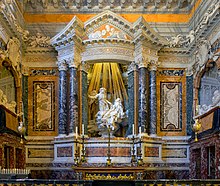St. Theresa rapture
The Rapture of St. Theresa (also called The Rapture of St. Theresa ) is a frontal sculpture by Giovanni Lorenzo Bernini . The 350 cm high masterpiece made of white Carrara marble , created between 1645 and 1652, combines several incidents, of which the saint reports in her self-confession, into one scene. The sculpture is now in the left transverse arm of the Church of Santa Maria della Vittoria in Rome , the Cornaro Chapel . She shows St. Theresa at the moment of her vision, when an angel pierces her heart with the arrow of divine love.
Theresa had described this experience in her autobiography with the following words:
- “Right next to me I saw an angel in perfect physical form. The angel was rather small than big, very beautiful, and his face shone with such brilliance that he had to belong to those angels who are completely illuminated by the fire of divine love; it must be those who are called seraphs . In the angel's hand I saw a long golden arrow with fire on the tip. It seemed to me as if he thrust it into my heart several times, I felt the iron penetrate my core, and when he pulled it out I felt as if it were taking my heart with it, and I remained filled with a fiery love for God. The pain was so intense that I cried out in plaintive voice. But at the same time I felt such an infinite sweetness that I wished the pain to last forever. It was not physical, but emotional pain, although to a certain extent it also affected the body; sweetest caress that God can give the soul. "
The altar is designed like a theater stage - an impression that is reinforced by the boxes on the left and right , from which members of the Cornaro family view the sacred events with very different emotions. The light effects and the intense colors of the stone used also focus the viewer's attention on the depiction and thus include them in the action.
The frame around the group of figures, constructed like a tabernacle , alludes both to the Eucharist and to the place where it happened. (It is generally believed that Theresa received her visions in the choir of the Convento de la Encarnación church in Avila .)
Some art historians considered the possibility of a sexual interpretation of the sculpture. Friedrich Müller, for example, described it in his work The Artists of All Times and Nations (1857) as
- "A group in which the saint in hysterical impotence, with broken eyes, lying on a cloud mass, stretches her limbs while a lustful angel with an arrow (here the symbol of divine love) aims at her"
The coroner and sex researcher Richard von Krafft-Ebing cited the work in his Psychopathia sexualis as an example of the "often stated relationship between religion, lust and cruelty" .
Egon Friedell writes about the art of the baroque in his cultural history of the modern age (1931) :
- “Ultimately, eroticism , algolagnia and longing for the supernatural unite to form that bizarre mixture, the most overwhelming expression of which is Bernini's Saint Therese, a work that will at the same time remain eternally memorable through the sublime art of the most refined illusionary effects that otherwise only reach the stage. It is without a doubt a deeply religious conception; and yet you can feel everywhere, in the overall composition as well as in the arrangement of every detail, secret make-up and ramp. "
reception
Dan Brown has an episode of his novel " Illuminati " set in the church of Santa Maria della Vittoria, where the statue is located.
Individual evidence
- ↑ Thomas Gransow: Rome and the Vatican , accessed on August 27, 2006
- ^ Bussagli, Marco: Rome, art and architecture. Cologne 1999, pp. 539f., ISBN 3-8290-2258-1
- ^ Giovanni Lorenzo Bernini on textlog.de
- ↑ 14th edition, p. 10
- ^ Dan Brown: Illuminati. Lübbe, Bergisch Gladbach 2003, ISBN 3-404-14866-5

